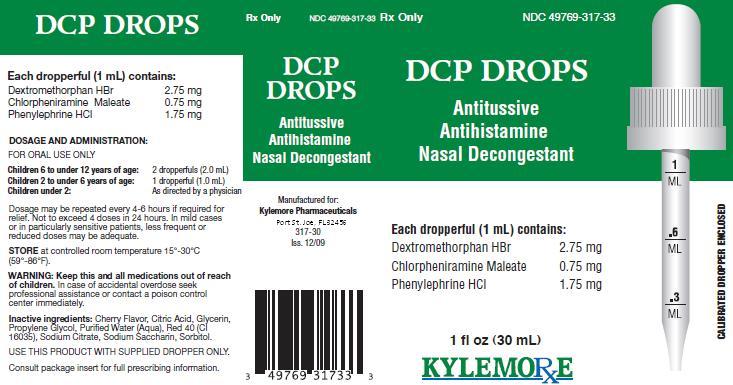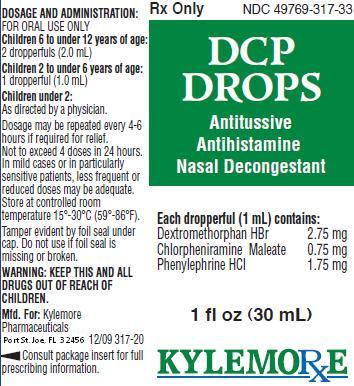DCP
-
dextromethorphan hydrobromide,
chlorpheniramine maleate and
phenylephrine hydrochloride liquid
Kylemore Pharmaceuticals, LLC
----------
DCP DROPSDESCRIPTION:
Each dropperful (1 mL) contains:Dextromethorphan HBr . . . . . . 2.75 mg
Chlorpheniramine Maleate . . . . . 0.75 mg
Phenylephrine HCl . . . . . . . . . . . 1.75 mg
Inactive Ingredients: Cherry Flavor, Citric Acid, Glycerin, Propylene Glycol, Purified Water (Aqua), Red 40 (CI 16035), Sodium Citrate, Sodium Saccharin, Sorbitol.
CLINICAL PHARMACOLOGY:
Antitussive, Antihistaminic, Nasal decongestant actions.Dextromethorphan HBr: Dextromethorphan HBr is a nonopiod antitussive agent. It suppresses the cough reflex by a direct action on the cough center in the medulla of the brain. Dextromethorphan HBr has no significant analgesic or sedative properties. It does not depress the respiration or predispose an individual to addiction with usual doses. In therapeutic dosage, Dextromethorphan HBr does not inhibit ciliary activity. The onset of action is typically within 30 minutes and the duration of actions can be up to 6 hours. Dextromethorphan is rapidly and extensively metabolized by the liver. It is primarily excreted in the kidneys as unchanged Dextromethorphan and demethylated metabolites including dextrophan, an active metabolite.
Phenylephrine Hydrochloride: Phenylephrine HCl, a nasal decongestant, is a potent postsynaptic alpha-receptor agonist with little effect on the beta receptors of the heart and no effect on the beta-adrenegic receptors of the bronchi or peripheral blood vessels. Therapeutic doses of phenylephrine HCl may cause vasoconstriction. It increases resistance and, to a lesser extent, decreases capacitance of blood vessels. Total peripheral resistance is increased, resulting in increased systolic and diastolic blood pressure. Pulmonary arterial pressure is usually increased, and renal blood flow is usually decreased. Local vasoconstriction and hemostasis occur following infiltration of phenylephrine HCl into tissues. The main effect of phenylephrine HCl on the heart is bradycardia; it produces a positive inotropic effect on the myocardium in doses greater than those usually used therapeutically. Rarely, the drug may increase the irritability of the heart which can cause arrhythmias. Cardiac output is decreased slightly. Phenylephrine HCl increases the work of the heart by increasing peripheral arterial resistance. Phenylephrine HCl has a mild central stimulant effect. Following oral administration of Phenylephrine HCl, constriction of blood vessels in the nasal mucosa relieves nasal congestion associated with allergy or head colds. This may occur within 15 or 20 minutes and may persist for up to 4 hours.
Chlorpheniramine Maleate: Chlorpheniramine Maleate possesses H1 antihistaminic activity and mild anticholinergic and sedative effects.
INDICATIONS AND USAGE:
For relief of coughs and upper respiratory symptoms, including nasal congestion, associated with allergy or the common cold.CONTRAINDICATIONS:
DCP DROPS is contraindicated in patients hypersensitive to any of its ingredients. It is also contraindicated in patients with severe hypertension or severe coronary artery disease, or in those receiving monoamine oxidase (MAO) inhibitors. Antihistamines should not be used to treat lower respiratory tract conditions including asthma.WARNINGS:
Sympathomimetic amines should be used with caution in patients with hypertension, ischemic heart disease, diabetes mellitus, increased intraocular pressure, hyperthyroidism, or prostatic hypertrophy. Sympathomimetics may produce central nervous system stimulation with convulsions or cardiovascular collapse with accompanying hypotension. Do not exceed recommended dosage.PRECAUTIONS:
General: The underlying cause of cough should be identified before prescribing this medication to suppress or lessen the cough. Avoid alcohol and other CNS depressants while taking this product. Patients sensitive to antihistamines may experience moderate to severe drowsiness.Information for Patients: Patients should be warned about engaging in activities requiring mental alertness, such as driving or operating dangerous machinery.
Drug Interactions: Antihistamines have additive effects with alcohol and other CNS depressants (hypnotics, sedatives, tranquilizers, antianxiety agents, etc. ). MAO inhibitors prolong and intensify the anticholinergic (drying) effects of antihistamines. MAO inhibitors may enhance the effect of Phenylephrine HCl. Sympathomimetics may reduce the effects of antihypertensive drugs.
Carcinogenesis, Mutagenesis and Impairment of Fertility: No data are currently available on long term potential for carcinogenesis, mutagenesis, or impairment of fertility in animals or humans.
Pregnancy: Pregnancy Category C: Animal reproduction studies have not been conducted with this product. It is not known whether this product can cause fetal harm when administered to pregnant women or affect reproduction capacity. Give to pregnant women only if clearly needed. Administration of Phenylephrine HCl to patients in late pregnancy or labor may cause fetal anoxia or bradycardia by increasing contractility of the uterus and decreasing uterine blood flow.
Nursing Mothers: Some sympathomimetics are excreted in breast milk. Use of this product by nursing mothers is not recommended.
ADVERSE REACTIONS:
Dextromethorphan HBr: Adverse effects with Dextromethorphan HBr are rare, but nausea and/or other gastrointestinal disturbances, headache, slight dizziness anddrowsiness can occur.Phenylephrine HCl: Hyper-reactive individuals may display ephedrine-like reactions such as tachycardia, palpitations, headache, dizziness, or nausea. Sympathomimetics have been associated with certain adverse reactions including fear, anxiety, nervousness, restlessness, tremor, weakness, pallor, respiratory difficulty, dysuria, insomnia, hallucinations, convulsions, CNS depression, arrhythmias, and cardiovascular collapse with hypotension.
Chlorpheniramine Maleate: Antihistamines may cause sedation, dizziness, diplopia, vomiting, diarrhea, dry mouth, headache, nervousness, nausea, anorexia, heartburn, weakness, polyuria and, rarely, excitability in children.
Call your doctor for medical advice about side effects. You may report side effects to the FDA at 1-800-FDA-1088.
OVERDOSAGE:
Signs and Symptoms: Overdosage with Dextromethorphan HBr may produce CNS excitement and mental confusion. Overdosage with sympathomimetic amines can cause hypertension, headache, convulsions, cerebral hemorrhage and vomiting may occur. Premature ventricular beats and short paroxysms of ventricular tachycardia may also occur. Headache may be a symptom of hypertension. Bradycardia may also be seen early in Phenylephrine HCl overdosage. Excessive CNS stimulation may result in excitement, tremor, restlessness, and insomnia. Other effects may include pallor, mydriasis, hyperglycemia, and urinary retention. Severe overdosage may cause tachypnea or hyperpnea, hallucinations, convulsions, or delirium, but in some individuals, there may be CNS depression. Arrhythmias (including ventricular fibrillation) may lead to hypotension and circulatory collapse. Severe hypokalemia can occur, probably due to a compartmental shift in potassium rather than by its depletion. Should antihistamine effects predominate, central action constitutes the greatest danger. In a small child, symptoms include excitation, hallucination, ataxia, lack of coordination, tremors, flushed face and fever. Convulsions, fixed and dilated pupils, coma and death may occur in severe cases. In the adult, fever and flushing are uncommon, excitement leading to convulsions and postictal depression is often preceded by drowsiness and coma. Respiration is usually not seriously depressed; blood pressure is usually stable.Treatment: The patient should be induced to vomit, even if emesis has occurred spontaneously. Pharmacologic vomiting by the administration of ipecac syrup is a preferred method, however, vomiting should not be induced in patients with impaired consciousness. Precautions against aspirations must be taken, especially in infants and children. Following emesis, any drug remaining in the stomach may be absorbed by activated charcoal administered as a slurry with water. Treatment of the signs and symptoms of overdosage is symptomatic and supportive.
DOSAGE AND ADMINISTRATION:
FOR ORAL USE ONLYChildren 6 to under 12 years of age:
2 dropperfuls (2.0 mL)
Children 2 to under 6 years of age:
1 dropperful (1.0 mL)
Children under 2:
As directed by a physician
May be repeated every 4-6 hours if required for relief. Not to exceed 4 doses in 24 hours. In mild cases or in particularly sensitive patients, less frequent or reduced doses may be adequate.
HOW SUPPLIED:
DCP DROPS is a sugar-free, alcohol-free, cherry-flavored liquid and is available in 1 fl oz (30 mL) bottles NDC 49769-317-33, with a calibrated (1 mL) dropper. Store at controlled room temperature 15°-30°C (59°-86°F).Tamper evident by foil seal under cap. Do not use if foil seal is missing or broken.
WARNING: KEEP THIS AND ALL DRUGS OUT OF REACH OF CHILDREN.
Rx ONLY
Manufactured For:
Kylemore Pharmaceuticals
Port St. Joe, FL 32456
317-10
Iss. 12/09
PACKAGING:
Sample carton:

Sample label:

| DCP
dextromethorphan hydrobromide, chlorpheniramine maleate, phenylephrine hydrochloride liquid |
||||||||||||||||||
|
||||||||||||||||||
|
||||||||||||||||||
|
||||||||||||||||||
|
||||||||||||||||||
|
||||||||||||||||||
| Marketing Information | |||
| Marketing Category | Application Number or Monograph Citation | Marketing Start Date | Marketing End Date |
| unapproved drug other | 01/01/2010 | 03/16/2011 | |
| Labeler - Kylemore Pharmaceuticals, LLC (831892471) |